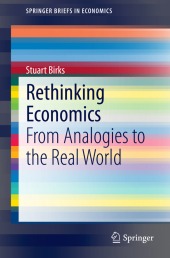 Neuerscheinungen 2014Stand: 2020-02-01 |
Schnellsuche
ISBN/Stichwort/Autor
|
Herderstraße 10
10625 Berlin
Tel.: 030 315 714 16
Fax 030 315 714 14
info@buchspektrum.de |

Stuart Birks
Rethinking Economics
From Analogies to the Real World
2015. 2014. xii, 87 S. 2 SW-Abb. 235 mm
Verlag/Jahr: SPRINGER, BERLIN; SPRINGER SINGAPORE; SPRINGER 2014
ISBN: 9812871756 (9812871756)
Neue ISBN: 978-9812871756 (9789812871756)
Preis und Lieferzeit: Bitte klicken
This brief responds to the criticism that mainstream economics is currently facing due to its heavy reliance on models and narrow range of quantitative research techniques. It takes a broader view, identifying issues that are also relevant for heterodox and pluralist approaches to economics. By acknowledging that the world of theory is not the same as the reality that we are trying to understand, the brief focuses on three paths that generally receive little attention. These are: from theory to the real world; from theory to empirical analysis; and from empirical results to policy application. Each path highlights a range of related concerns and qualifications, and the focus on these transitions provides a strong basis for critical evaluation of analyses and potentially more realistic results and recommendations. It also provides a framework for synthesizing information from alternative schools of thought and across disciplines. In addition, the importance of framing and rhetoric is demonstrated. The brief addresses philosophical and methodological issues using a clear, non-technical approach that can be easily understood by a non-specialist audience.
Preface.- Acknowledgements.- Chapter 1: The importance of rhetoric and framing.- 1.1: Three paths.- 1.2: Rhetoric and framing.-1.2.1: Rhetoric.- 1.2.2: Framing.- Chapter 2: Logical gaps: Path A - Theory to the real world.- 2.1: What is theory?.- 2.2.: Limits of theory.- 2.2.1: Perfect competition and counterfactuals.- 2.2.2: Accepting or rejecting a theory.- 2.2.3: Evidence consistent with theory.- 2.2.4: An additional consideration: the importance of groups.- 2.3: Conclusions.- Chapter 3: Logical gaps: Path B - Theory to empirical formulations.- 3.1: Data problems.- 3.1.1: Aggregation.- 3.1.2: Proxies.- 3.1.3: More on indices.- 3.2: Functional forms.- 3.2.1: Controlling for other factors.- 3.2.2: Causality.- 3.2.3: Structural stability.- 3.3: Conclusions.- Chapter 4: Logical gaps: Path C - Empirical results to the real world.- 4.1: Using statistics for policy.- 4.1.1: The research phase.- 4.1.2: The media phase.- 4.2: Consideration of the problems.- 4.2.1: Interpretation of statistical significance.- 4.2.2: Interpretation: why not change the relationship?.- 4.3: There are standard policy questions not covered by the econometrics.- 4.3.1: An example - TV watching and attention problems.- 4.3.2: Policy questions.- 4.4: An additional example: advantage and disadvantage.- 4.5: Conclusions.- Chapter 5: A way forward.- 5.1: An example: efficiency in economics research.- 5.2: A broader context.- 5.3: In a nutshell.- 5.4: And a final word.- Appendix.- References.-
After studying mathematical economics and econometrics, Stuart worked as an economist in multi-disciplinary teams undertaking regional strategic planning. He then returned to the academic world, specializing in applying economics in relation to land, health, education, social policy and law. His experience in cross-disciplinary work combined with an interest in broader methodological issues provided insights other than those afforded by a conventional academic within-discipline perspective. This blended well with his teaching, which has focused on graduate-level courses, many of which have been to mature students with professional experience in a wide range of areas. He has been recognized with Life Membership of the New Zealand Association of Economists and an award of Fellow of the Law and Economics Association of New Zealand.


